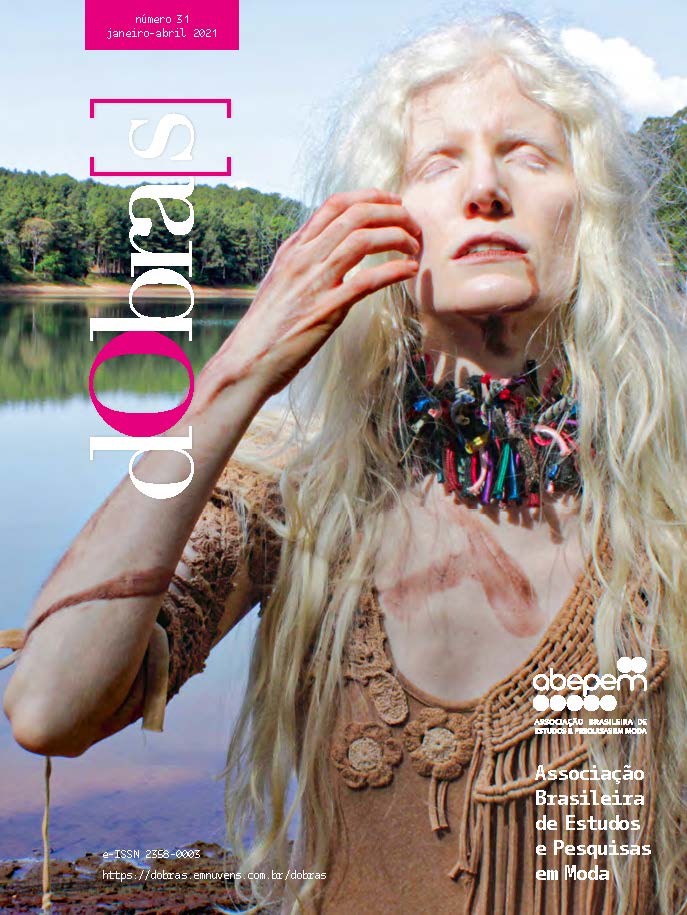Covering/uncovering
current and past cultural intertwining
DOI:
https://doi.org/10.26563/dobras.i31.1287Keywords:
Semiotics of Culture, Fashion, Modest FashionAbstract
According to Jurij Lotman (2006), the cultural intertwining that characterisethe human behaviour in various periods can be defined as mythology of everyday andsocial behaviour. Starting from this methodological assumption, the article investigatesthe dynamics of covering/uncovering in dress fashion along three paragraphs. The first isdedicated to the link between images of veiling and mourning, both in western Christianand pre-Christian cultures. Protective coverings for COVID, and other recent phenomenasuch as the black dress code of the #MeToo movement, have their roots in this tradition. Inthe second paragraph, the reflection is based on the opposition between / must be seen/vs / must not be seen/, which generates regimes of /constraint/, /taboo/, /transgressivestyle/ / and /casual style/. In the western context it seems that a neutral term has now become established, that is a randomness of styles (/neither transgressive, nor casual/)while the more traditionalist Islam seems to remain within the /taboo/ by imposing onwomen, the use of the veil and body cover, albeit with variations. However, in the thirdand last paragraph I will discuss the so-called Islamic modest fashion, a relatively recentphenomenon that seems to create an unprecedented complex term, which combines thetraditional restrictions for women’s dressing with an increased attention to eleganceand ease of movement. In conclusion, we will reflect on the wider cultural context of thischange, since the hegemony of transgression or randomness of Western customs seem tobe largely declining globally, with further examples in television series and films production.
Downloads
References
BHABHA, Homi K. La questione dell’Altro. Stereotipo, discriminazione e discorso delcolonialismo. In: BIANCHI, Cinzia; DEMARIA, Cristina; NERGAARD, Siri (a cura di). Spettridel potere. Ideologia identità traduzione negli studi culturali. Roma: Meltemi, 2002.
BHUTTO, Fatima. New kings of the world. Dispatches from Bollywood, Dizi, and K-Pop.New York: Columbia University Press, 2019.
BELTING, Hans. Faces: eine geschichte des gesichts. München: München: C. H. Beck, 2013;trad. italiana Facce. Storia del volto. Roma: Carocci, 2014.
CALVINO, Italo. Palomar. Torino: Einaudi, 1983.
CORRAIN, Lucia. Il velo dell’arte. Una rete di immagini tra passato e contemporaneità.Firenze-Lucca: VoLo publisher, 2016.
ECO, Umberto. Apocalittici e integrati. Milano: Bompiani, 1963.
ECO, Umberto. A passi di gambero. Guerre calde e populismo mediatico. Milano:Bompiani, 2006.
FLOCH, Jean-Marie. Identités visuelles. Paris: Presses Universitaires de France,1995, trad.it. Identità visive. Milano: Angeli, 1997.
HOUELLEBECQ, Michel. Soumission. Paris: Flammarion, 2015.
LANDOWSKI, Eric; FIORIN, Josè Luiz. O gosto da gente, o gosto das coisas: abordagemsemiótica. São Paulo: EDUC, 1997, trad. it. Gusti e disgusti. Sociosemiotica del quotidiano.Torino: Testo & Immagine, 2000.
LLEWELLYN-JONES, Lloyd. Aphrodite’s Tortoise: The Veiled Woman of Ancient Greece.Swansea: The Classical Press of Wales, 2003.
LOTMAN, Jurij. Dekabrist v povsednevnoj žizni (Bytovoe povedenie kak istorikopsichologičeskajakategorija). In: V.G. Bazanov – V.E. Vacuro Literaturnoe nasledie dekabristov. Leningrad:Nauka, 1975. trad. italiana Il decabrista nella vita. Il gesto, l’azione, il comportamento cometesto. In: LOTMAN, Jurij. Trad. M. Boffito. Da Rousseau a Tolstoj. Saggi sulla cultura russa.Bologna: Il Mulino, 1984.
LOTMAN, Jurij. Poetica bytvogo povedenija v russkoj kul’ture XVIII veka. In: Trudy poznakovym sistemam, n. 9, 1977, p. 65-89, trad. it. Lo stile, la parte, l’intreccio. La poetica delcomportamento quotidiano nella cultura russa del XVIII secolo in Lotman 2006.
LOTMAN, Jurij. Tesi per una semiotica delle culture. Roma: Meltemi, 2006.MAGLI, Patrizia. Pitturare il volto. Il trucco, l’arte, la moda. Venezia: Marsilio, 2013.PEZZINI, Isabella, TERRACCIANO, Bianca (a cura di). La moda. Fra senso e cambiamento.Roma: Meltemi, 2020.
POZZATO, Maria Pia. Foto di matrimonio. Analisi di una trasformazione estetica e sociale a partire dagli anni sessanta. In: Pozzato, Maria Pia. Foto di matrimonio e altri saggi. Milano: Bompiani, 2012a, p. 35- 98.
POZZATO, Maria Pia. Il velo. Un problema di semiotica della cultura. In: Pozzato, Maria Pia. Foto di matrimonio e altri saggi. Milano: Bompiani, 2012b, p. 129-145.
POZZATO, Maria Pia. Dal velo tradizionale alla modest fashion islamica. In: Pezzini, Isabella; Terracciano, Bianca (a cura di), 2020, p. 177-198.
Downloads
Published
How to Cite
Issue
Section
License
The copyrights of the works published in this journal belong to the author, and dObra[s] holds the rights of first publication. Due to their publication in this open access journal, any work here is free to use, with its own attributions, in educational and non-commercial applications.










